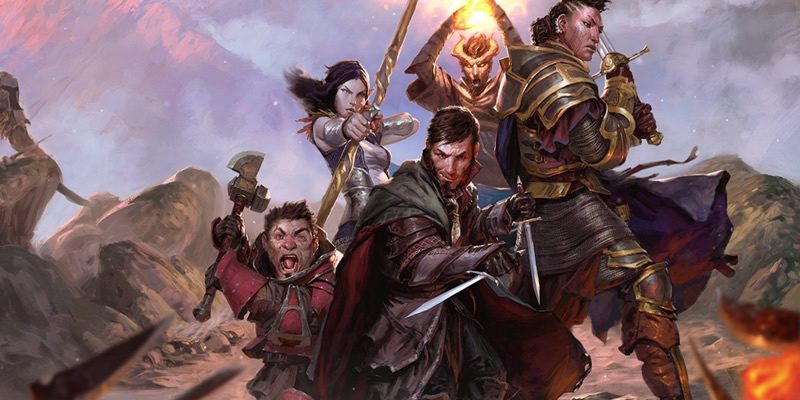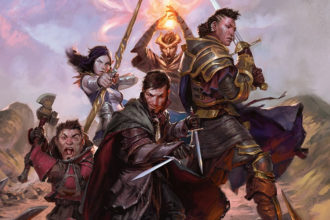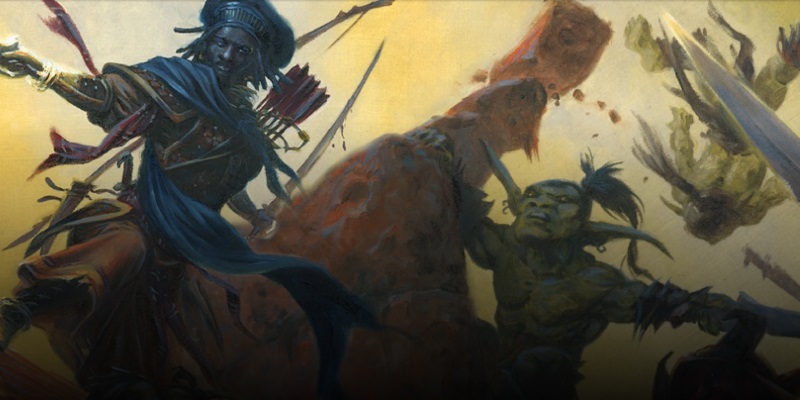Unearthed Arcana: Races of Eberron Breakdown

Today was huge in the world of 5e D&D. Even if it wasn’t as hyped as the Stream of Many Eyes, today we got announcements of two settings – one new to D&D, and one returning champion. I don’t know about y’all, and the comments field of this article isn’t the place for it, but I am – as the kids say – heckin’ thrilled. (Is that what the kids say? I just finished playing a board game with my teenage nephews and I would believe almost anything right now.)
The previous UA draft of Eberron races goes a long way back, to the early days of 5e UAs, before I was doing breakdowns for all of them. Let’s go with “it got some blowback,” and y’all will just understand that I’m mainly talking about the Artificer Tradition for wizards. Today a new version dropped, both in UA and in the DM’s Guild. You’re reading my breakdown of UA only, as you can tell from the title. The DM’s Guild version will get coverage at some point in the future.
I should also say that I am a big ol’ fan of Eberron and Keith Baker in general. He is a super nice guy who let me rave about Eberron at him last year at GenCon. I am extra happy to see him working with the setting in an official capacity again.
Changelings
I faded out of following Eberron closely in late 3.5 and 4e, so it may be that everything in the flavor text here was part of those versions of the setting. To me, though, some of what this says about changeling society and uses of masks and personas is new and cool.
- +2 Cha and either +1 Dex or +1 Int. I love “A and (B or C)” format for ability score modifiers from race, personally.
- Speed of 30 ft, of course.
- Change Appearance is fairly text-intensive for a racial feature, but it does exactly what I would have assumed. It doesn’t change your clothes or other gear, which means you still need to get in fights to capture uniforms for infiltration missions. You can’t duplicate the appearance of someone you haven’t seen.
- Changeling Instincts grants proficiency in two skills, out of Deception, Insight, Intimidation, and Persuasion. Two skill proficiencies is pretty boss for a racial feature.
- Unsettling Visage lets you impose disadvantage on an incoming attack. The text calls out that you have to decide whether to use this feature before you know the result of the roll, which should be redundant – that’s what “imposes disadvantage” means, as opposed to “must reroll and take the lower result.” Anyway, this is a neat move that fits the supporting fiction of shapeshifters. I like it.
- Divergent Persona grants you a tool proficiency, and doubles your proficiency bonus with that when you’re in the appropriate character for it. This is a good support for the flavor text.
- Changelings gain Common + 2 languages.
Personally, I think Change Appearance gives so much spotlight time and problem-solving/-causing power that it could have been literally the only feature, and it would still sometimes toe the line of being a problem. (Miss me with “nah, just be a better DM.” That’s the least useful of all responses.) Ultimately, though, I don’t have a problem with what I see in this set of racial features.
Kalashtar
The kalashtar story, for PCs, is about being a combatant in a secret, esoteric war for control of reality. You can reasonably be mistaken for a human, especially if psions are a going concern in Khorvaire among all the races. More than most PC concepts, kalashtar bring elements of modern occult horror (Mage, Unknown Armies, Over the Edge) into Eberron.
- Kalashtar gain a Quirk based on their quori spirit. These are no weirder than existing Personality Traits, and I like them fine.
- +1 Wis, +1 Cha, +1 to one ability score. You can stack this up on Wis or Cha, or spread your bonuses around.
- Speed of 30 ft.
- Dual Mind lets you spend a reaction to gain advantage on a Wisdom save. I like this more than always-on advantage against every kind of Wisdom save, anyway.
- Mental Discipline grants resistance to psychic damage. Makes sense.
- Mind Link grants telepathy with a 60-ft range; you can also let that creature respond to you telepathically, though it takes a small investment of effort from you.
- Psychic Glamour you pick one of Insight, Intimidation, Performance, or Persuasion, and gain always-on advantage with it. I’m… not wild about that, but it’s not the worst.
- Severed from Dreams grants immunity to dream-based effects, but not sleep as such. That’s probably a narrow enough immunity that I don’t object as I would to any other player-side immunity.
- Kalashtar gain Common, Quori, and one other language.
These features are pretty laser-focused on the story of “outwardly human but with psychic defenses and telepathy.” Overall, I like it fine. I don’t remember what kind of mechanical support the kalashtar Path of Light philosophy got earlier editions, but I hope that the DM’s Guild document offers some support.
Shifter
I’ve never gotten into the shifter story, or for that matter the Eldeen Reaches story, the way I have with some other parts of the setting. I don’t dislike them, I’m just a lot more invested in some other conflicts. That’s where I am with Werewolf: the Apocalypse and Werewolf: the Forsaken, too, so… trend-line I guess.
- +1 Dex. (You’ve got more coming to you from your subrace.)
- Speed of 30 feet, except for swiftstride shifters.
- 60-ft darkvision, like y’do.
- Keen Senses grants proficiency in Perception.
- Shifting describes the universal elements of shifting – bonus action to use, 1-min duration, a decent pool of temporary hit points, once per short rest. All of the subraces build on this.
- You only gain proficiency in Common.
Beasthide
- +2 Con.
- Proficiency in Athletics.
- When you shift, you gain 1d6 more temporary hit points, and 1 point of AC.
- Those extra temporary hit points are huge at lower levels but don’t feel like much (relative to your increasing number of temporary hit points) at higher levels, and a 1-min-per-short-rest bonus to AC is kinda fiddly. This could be more interesting, but I’ll grant that its themes are hard to do well.
Longtooth
- +2 Str.
- Proficiency in Intimidation.
- While shifted, you can bite for 1d6 + Str as a bonus action. That’s super good – compare it to the Berserker’s Frenzy bonus attack. Smaller die size, no magic bonus, but no exhaustion and resets with a short rest? Hoo boy.
Swiftstride
- +1 Dex (total of +2) and +1 Cha. That +1 Cha presumably carries the “difficult to pin down socially” idea from the flavor text. Especially with that Dex bonus, I think it amounts to making a good bard subrace.
- Proficiency in Acrobatics.
- Swift Stride gives them +5 ft walking speed.
- While shifted, you gain another +5 ft of walking speed, and you can spend your reaction to dart away from people who end their turns within 5 feet of you. That movement doesn’t provoke OAs, though they’ve presumably already made whatever attack they’re going to make. It just means you can position yourself to move freely when your own turn comes around again.
Wildhunt
- +2 Wis.
- Proficiency in Survival.
- Mark the Scent helps you track a creature by scent at a distance, and you can always locate the creature within 60 feet. You do have to get within 10 feet of the creature to mark it in the first place. I like it.
- While shifted, you gain advantage on Wisdom checks. This is great for rangers, and probably underwhelming for anyone else. The problem with it (even for rangers) is that shifting only lasts one minute, but the situations where you want to make a lot of Wisdom checks are generally outside of combat and often take place over longer spans of time than 1 minute. I’d like to see this one reworked.
Overall, shifters still don’t appeal to me as much as the other races do. I’m not crazy about the proliferation of skill proficiencies from race – I’m inclined to see it as power creep. I would give a wildhunt druid a try, potentially.
Warforged
This is, almost without debate, the most popular of the Eberron-specific races. I mean, you get to play with golem or robot themes, you get to call your companions organics meatbags, what’s not to like? The warforged racial story is one of my favorite pieces of Eberron’s lore, especially in its room for mysteries.
- The Warforged Quirks table is here to set you up for more ways to steal dialogue from C-3PO, HK-47, or Lieutenant Commander Data. Or to tell some difficult stories about PTSD, if that’s the direction you wanted to go with it.
- +1 Con; as with shifters, they gain 2 ability score points from their subrace.
- Speed of 30 ft, except for skirmisher warforged.
- Notably, they’ve done away with the rules around difficulty in healing warforged with cure wounds and similar magic. (They probably made this change in 4e, but I didn’t pay attention then.)
- Warforged Resilience has a lot going on, because it has to communicate that you are more machine than human.
- Advantage on saves against poison, and resistance to poison damage. Yay no immunity!
- Immune to disease. Boo, immunity! Boo, making harm explicitly a disease!
- You don’t drink, don’t breathe (what do you do?), and don’t eat.
- You don’t sleep, magic can’t put you to sleep, and lack of rest can’t cause you exhaustion. (Things other than lack of rest, like a Berserker’s frenzy attack, can.)
- Sentry’s Rest lets you keep watch while motionless and “resting.” This is fine.
- Integrated Protection is a far more elegant approach to warforged armor plating than we saw in 3.5. You can choose from three different weights of armor plating as part of a long rest. The visual that I get from this is less “detaching plates by hand” and more “rearranging parts of your body and turning plates around to transform.” The armor options are super good, because you get to add your proficiency bonus on top of a small armor number and – for light and medium versions – some of your Dex modifier. That’s the balance for (presumably) no way to upgrade your armor in the course of play. In low-magic-item games, this feature is utterly dominating; in others, it’s merely good.
- You can speak, read, and write Common.
Envoy
- +1 to each of two different ability scores. You can stack this with your Con bonus from your core racial features, of course.
- You are designed to be proficient in one skill, one tool, and one language. That’s a far cry from the six million forms of communication you should be fluent in, of course. If only you had applied yourself at Warforged School.
- Integrated Tool gives you one built-in tool, and you double your proficiency bonus with it. I don’t know what to tell you, you’ve gone from being HK-47 to Inspector Gadget. My condolences. (Who am I kidding, this feature is a really neat idea.)
Juggernaut
- The flavor text here is confusing and I don’t know if you’re played by Terrence Howard, Don Cheadle, Vinnie Jones, or Deadpool’s alter ego.
- +2 Strength.
- Your unarmed strike damage is 1d4 + Str. Still not enough to be a full-time brawler, but it’s better than nothing.
- Powerful Build makes you a workhorse for carrying, lifting, and dragging. Sure, that’s fine.
Um, if you’re picking this one for mechanical reasons, you’re here for +2 Str. The other two features are neat but won’t come up nearly often enough to be your reason to pick this.
Skirmisher
- +2 Dex.
- +5 ft walking speed.
- Light Step: When traveling alone (which… you won’t do often in tabletop gaming), you can move at full speed without breaking stealth. This should get tweaked to allow you to accompany other characters who have the same feature.
Overall I like the warforged fine. I think the Juggernaut doesn’t live up to the coolness it sounds like it’s bringing to the table, and the Envoy is surprisingly promising (because, well, thieves’ tools with Expertise).
Stepping back a bit further, I plan to cover the rest of the Wayfinder’s Guide to Eberron soon, probably for next week’s article. Whatever my quibbles with the racial mechanics here, this continues to be one of my favorite published settings. Only Planescape can match it for the variety of moods and subgenres that are explicitly included.



